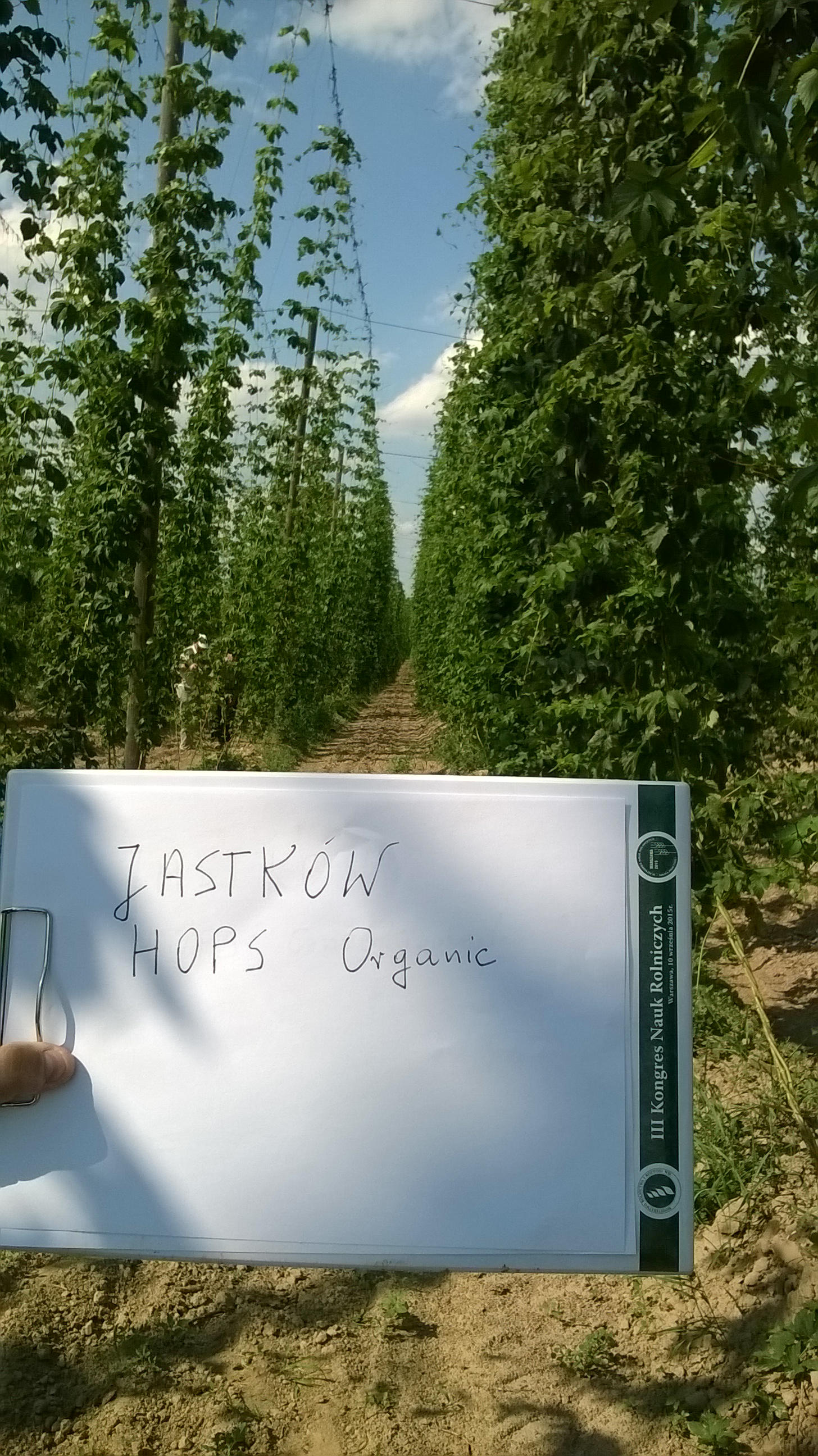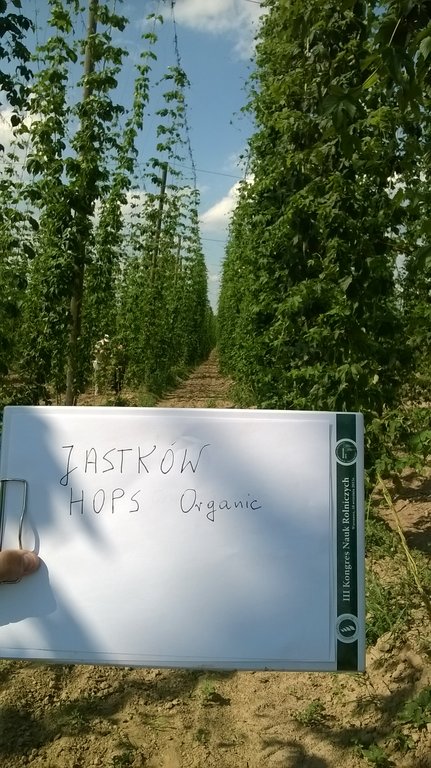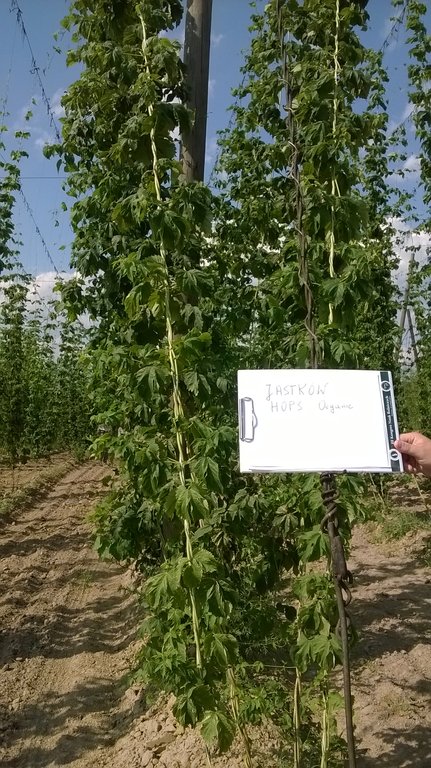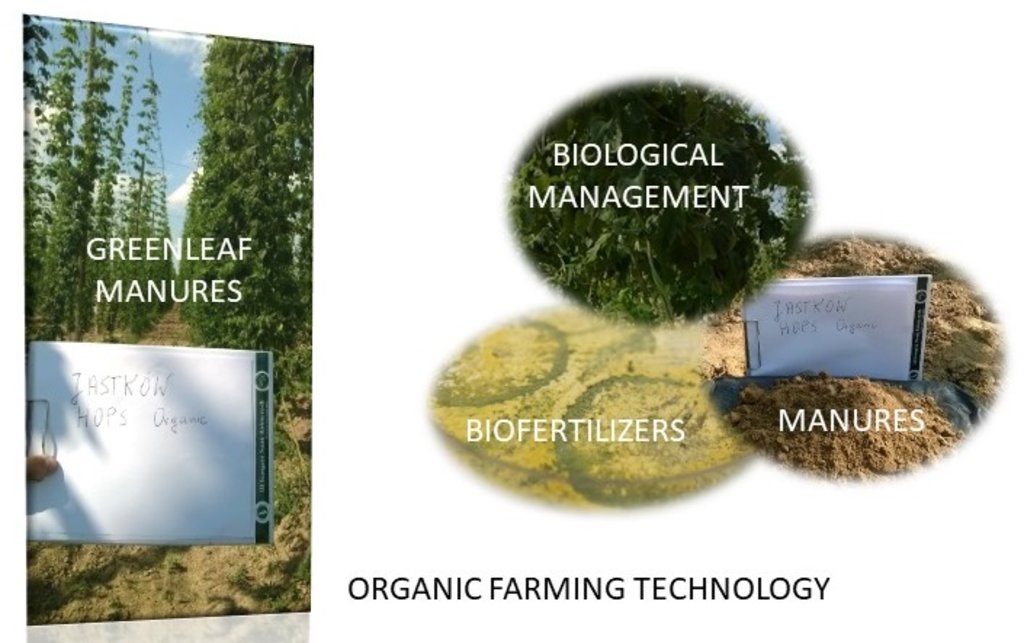Organic agriculture in hop cultivation [波兰]
- 创建:
- 更新:
- 编制者: Magdalena Frac
- 编辑者: –
- 审查者: Ursula Gaemperli, Gudrun Schwilch
Organic agriculture in hop cultivation
technologies_2852 - 波兰
查看章节
全部展开 全部收起1. 一般信息
1.2 参与该技术评估和文件编制的资源人员和机构的联系方式
Lipiec Jerzy
j.lipiec@ipan.lublin.pl
Institute of Agrophysics, Polish Academy of Sciences
Doswiadczalna 4, 20-290 Lublin
波兰
Usowicz Bogusław
b.usowicz@ipan.lublin.pl
Institute of Agrophysics, Polish Academy of Sciences
Doswiadczalna 4, 20-290 Lublin
波兰
有助于对技术进行记录/评估的项目名称(如相关)
Interactive Soil Quality assessment in Europe and China for Agricultural productivity and Environmental Resilience (EU-iSQAPER)有助于对技术进行记录/评估的机构名称(如相关)
Institute of Agrophysics, Polish Academy of Sciences (IA PAS) - 波兰1.3 关于使用通过WOCAT记录的数据的条件
(现场)数据是什么时候汇编的?:
30/06/2016
编制者和关键资源人员接受有关使用通过WOCAT记录数据的条件。:
是
1.4 所述技术的可持续性声明
这里所描述的技术在土地退化方面是否存在问题,导致无法被认为是一种可持续的土地管理技术?:
否
2. SLM技术的说明
2.1 技术简介
技术定义:
Integrated pest and disease management including organic agriculture.
2.2 技术的详细说明
说明:
The technology is used in Jastków (N 51.302029 E 22.42336), in Lubelskie Region in Poland under hops. The size of farm with organic hops production is about 6 ha. The case study is embedded in typical agricultural region on rather fertile soils formed from loess. The altitude in the study site is 209 m.a.s.l., average annual temperature 8°C and precipitation 540 mm.
The main characteristics of the technology are the following:
- very strict limits on chemical synthetic pesticide and synthetic fertiliser use,
- absolute prohibition of the use of genetically modified organisms,
- taking advantage of on-site resources, such as composts produced on the farm,
- application of beneficial microorganisms and plants extracts for pest and diseases control. Appropriate measures that discourage the development of pest populations and keep pesticides and other interventions to reduce or minimize risks to human health and the environment.
Organic farming promotes the use of cover crops and crop rotations. Organic residues and nutrients produced on the farm are recycled back to the soil. Cover crops and composted manure are used to maintain soil organic matter and fertility. Preventative disease control methods are practiced, including crop rotation. Integrated pest and weed management, and soil conservation systems are valuable tools on an organic farm. The organic farming technology increases the quality of plants, decreases fertilizers and pesticides use, builds healthy soil, supports water conservation, encourages biodiversity. The major activities needed to establish and maintain the Technology are the following: poles for hops growth, natural fertilizers and bioproducts used in organic farming.
Important principles for the processing of organic products include the keeping agriculture in touch with nature.
The benefits of the Technology are the following:
- responsible use of energy and natural resources,
- maintenance of biodiversity,
- enhancement of soil fertility,
- maintenance of water quality.
The farmers can have a problem with pest and diseases, hovewer they like the yield quality of plants cultivated in organic farming system.
2.3 技术照片
2.5 已应用该技术的、本评估所涵盖的国家/地区/地点
国家:
波兰
有关地点的进一步说明:
Jastków
注释:
Jastków, Poland, Organic plantation of hops, Coordinates: N 51.30203 E 22.42336
Map
×2.6 实施日期
如果不知道确切的年份,请说明大概的日期:
- 不到10年前(最近)
2.7 技术介绍
详细说明该技术是如何引入的:
- 通过项目/外部干预
注释(项目类型等):
The Farmer collaborated with Life Sciences University in Lublin to evaluate the influence of different bioproducts in organic farming system.
3. SLM技术的分类
3.1 该技术的主要目的
- 改良生产
- 减少、预防、恢复土地退化
- 保持/提高生物多样性
- 创造有益的经济影响
- 创造有益的社会影响
3.2 应用该技术的当前土地利用类型

农田
- 多年一作(非木材)
主要农作物(经济作物及粮食作物):
hop
如果由于技术的实施而导致土地用途发生变化,则在技术实施前说明土地利的用途。:
Conventional agriculture.
3.3 有关土地利用的更多信息
该技术所应用土地的供水:
- 雨养
每年的生长季节数:
- 1
3.4 该技术所属的SLM组
- 病虫害综合管理(包括有机农业)
3.5 技术传播
具体说明该技术的分布:
- 均匀地分布在一个区域
如果该技术均匀地分布在一个区域上,请注明覆盖的大致区域。:
- < 0.1 平方千米(10 公顷)
3.6 包含该技术的可持续土地管理措施

农艺措施
- A2:有机质/土壤肥力

管理措施
- M2:改变管理/强度级别
注释:
Organic hops plantation.
3.7 该技术强调的主要土地退化类型

化学性土壤退化
- Cn:肥力下降和有机质含量下降(非侵蚀所致)
- Cp:土壤污染

生物性退化
- Bq:数量/生物量减少
- Bl:土壤寿命损失

水质恶化
- Hq:地下水水质下降
3.8 防止、减少或恢复土地退化
具体数量名该技术与土地退化有关的目标:
- 防止土地退化
4. 技术规范、实施活动、投入和成本
4.1 该技术的技术图纸
4.2 技术规范/技术图纸说明
Infografics presents the organic farming technology: high plant and soil quality and beneficial microorganisms application.
The main characteristics of the technology are the following:
- very strict limits on chemical synthetic pesticide and synthetic fertiliser use (BIOLOGICAL MANAGAMENT),
- taking advantage of on-site resources, such as composts produced on the farm (MANURES),
- application of beneficial microorganisms and plants extracts for pest and diseases control (BIOFERTILIZERS).
4.3 有关投入和成本计算的一般信息
具体说明成本和投入是如何计算的:
- 每个技术区域
注明尺寸和面积单位:
1 ha
其它/国家货币(具体说明):
PLN
注明美元与当地货币的汇率(如相关):1美元=:
0.28
注明雇用劳工的每日平均工资成本:
50-100 PLN
4.4 技术建立活动
| 活动 | 措施类型 | 时间 | |
|---|---|---|---|
| 1. | Building of terraces | 管理 | Spring, Summer or Autumn |
| 2. | Manure storage | 管理 | Spring, Summer or Autumn |
4.5 技术建立所需要的费用和投入
如果可能,按下表分列技术建立费用,并列明各项投入和每项投入的费用。如果您无法分解成本,给出建立该技术的总成本估算。:
5000.0
注释:
The costs include building of terraces for hop production and costs of plants.
4.6 维护/经常性活动
| 活动 | 措施类型 | 时间/频率 | |
|---|---|---|---|
| 1. | Biofertilizers application | 农业学的 | Spring, Summer or Autumn |
| 2. | Pests and diseases control (plants extracts application) | 管理 | Spring, Summer or Autumn |
4.7 维护/经常性活动所需要的费用和投入(每年)
如果可能,按下表分解技术维护费用,并列明各项投入和每项投入的费用。如果您无法分解成本,给出维护该技术的总成本估算。:
500.0
4.8 影响成本的最重要因素
描述影响成本的最决定性因素:
Energy, equipment and labour.
5. 自然和人文环境
5.1 气候
年降雨量
- < 250毫米
- 251-500毫米
- 501-750毫米
- 751-1,000毫米
- 1,001-1,500毫米
- 1,501-2,000毫米
- 2,001-3,000毫米
- 3,001-4,000毫米
- > 4,000毫米
农业气候带
- 半湿润
5.2 地形
平均坡度:
- 水平(0-2%)
- 缓降(3-5%)
- 平缓(6-10%)
- 滚坡(11-15%)
- 崎岖(16-30%)
- 陡峭(31-60%)
- 非常陡峭(>60%)
地形:
- 高原/平原
- 山脊
- 山坡
- 山地斜坡
- 麓坡
- 谷底
垂直分布带:
- 0-100 m a.s.l.
- 101-500 m a.s.l.
- 501-1,000 m a.s.l.
- 1,001-1,500 m a.s.l.
- 1,501-2,000 m a.s.l.
- 2,001-2,500 m a.s.l.
- 2,501-3,000 m a.s.l.
- 3,001-4,000 m a.s.l.
- > 4,000 m a.s.l.
说明该技术是否专门应用于:
- 不相关
5.3 土壤
平均土层深度:
- 非常浅(0-20厘米)
- 浅(21-50厘米)
- 中等深度(51-80厘米)
- 深(81-120厘米)
- 非常深(> 120厘米)
土壤质地(表土):
- 中粒(壤土、粉土)
土壤质地(地表以下> 20厘米):
- 中粒(壤土、粉土)
表土有机质:
- 中(1-3%)
5.4 水资源可用性和质量
地下水位表:
5-50米
地表水的可用性:
好
水质(未处理):
良好饮用水
水的盐度有问题吗?:
否
该区域正在发生洪水吗?:
否
5.5 生物多样性
物种多样性:
- 高
栖息地多样性:
- 中等
5.6 应用该技术的土地使用者的特征
定栖或游牧:
- 定栖的
生产系统的市场定位:
- 商业/市场
非农收入:
- > 收入的50%
相对财富水平:
- 平均水平
个人或集体:
- 个人/家庭
机械化水平:
- 机械化/电动
性别:
- 男人
土地使用者的年龄:
- 青年人
5.7 应用该技术的土地使用者拥有或租用的平均土地面积
- < 0.5 公顷
- 0.5-1 公顷
- 1-2 公顷
- 2-5公顷
- 5-15公顷
- 15-50公顷
- 50-100公顷
- 100-500公顷
- 500-1,000公顷
- 1,000-10,000公顷
- > 10,000公顷
这被认为是小规模、中规模还是大规模的(参照当地实际情况)?:
- 中等规模的
5.8 土地所有权、土地使用权和水使用权
- family
土地使用权:
- 个人
5.9 进入服务和基础设施的通道
健康:
- 贫瘠
- 适度的
- 好
教育:
- 贫瘠
- 适度的
- 好
技术援助:
- 贫瘠
- 适度的
- 好
就业(例如非农):
- 贫瘠
- 适度的
- 好
市场:
- 贫瘠
- 适度的
- 好
能源:
- 贫瘠
- 适度的
- 好
道路和交通:
- 贫瘠
- 适度的
- 好
饮用水和卫生设施:
- 贫瘠
- 适度的
- 好
金融服务:
- 贫瘠
- 适度的
- 好
6. 影响和结论性说明
6.1 该技术的现场影响
社会经济效应
生产
作物生产
注释/具体说明:
The farmer observed lower hops yield, however the quality is better.
作物质量
注释/具体说明:
The organic farming technology increases crop quality by reduction of fertilizers and pesticides use.
生产故障风险
注释/具体说明:
The organic farming technology decreases the risk of production failure due to greater yield quality and stability.
土地管理
注释/具体说明:
The organic farming technology simplifies land management by less intense machinery uses.
收入和成本
农业投入费用
注释/具体说明:
The expenses on agricultural inputs in organic farming technology are reduced due to lower fuel costs.
工作量
注释/具体说明:
The workload in organic farming technology increases by higher number of agricultural practices.
社会文化影响
食品安全/自给自足
注释/具体说明:
The no-till technology improves the food security by increased yield quality and stability.
SLM/土地退化知识
注释/具体说明:
Land degradation knowledge is improved by the promotion of the organic farming technology.
生态影响
水循环/径流
水质
注释/具体说明:
The water quality increases in organic farming technology due to lower uses of fertilizers and pesticides.
土壤
土壤有机物/地下C
注释/具体说明:
The organic farming technology increases soil soil organic matter content due to cover crops between rows and less mineralization of organic matter.
生物多样性:植被、动物
有益物种
注释/具体说明:
We observed greater quantity of earthworms under organic farming technology compared to the
conventional tilled soil.
害虫/疾病控制
注释/具体说明:
The use of pesticides and herbicides is not allowed, therefore only plant extracts or bioproducts are used.
减少气候和灾害风险
碳和温室气体的排放
注释/具体说明:
The organic farming technology desreases emission of carbon and greenhouse gases
due to reduction of chemicals uses and reduction of CO2 and other greenhouse gases realising by intensive agriculture.
6.4 成本效益分析
技术收益与技术建立成本相比如何(从土地使用者的角度看)?
短期回报:
中性/平衡
长期回报:
非常积极
技术收益与技术维护成本/经常性成本相比如何(从土地使用者的角度看)?
短期回报:
中性/平衡
长期回报:
非常积极
6.5 技术采用
- 单例/实验
如若可行,进行量化(住户数量和/或覆盖面积):
about 6 ha
在所有采用这项技术的人当中,有多少人是自发地采用该技术,即未获得任何物质奖励/付款?:
- 0-10%
注释:
The farmer collaborates with local research units.
6.6 适应
最近是否对该技术进行了修改以适应不断变化的条件?:
否
6.7 该技术的优点/长处/机会
| 土地使用者眼中的长处/优势/机会 |
|---|
| Emphasizes the growth of a healthy crop with the least possible disruption to agro-ecosystems and encourages natural pest control mechanisms. |
| 编制者或其他关键资源人员认为的长处/优势/机会 |
|---|
| Emphasizes the growth of a healthy crop with the least possible disruption to agro-ecosystems and encourages natural pest control mechanisms. |
6.8 技术的弱点/缺点/风险及其克服方法
| 土地使用者认为的弱点/缺点/风险 | 如何克服它们? |
|---|---|
| Plant diseases, weeds growth | Biological plant protection |
| Low crop yield, high costs of production | Buying cheaper bio-preparations |
| 编制者或其他关键资源人员认为的弱点/缺点/风险 | 如何克服它们? |
|---|---|
| Plant diseases, weeds growth | Biological plant protection |
7. 参考和链接
7.1 信息的方法/来源
- 实地考察、实地调查
2
- 与土地使用者的访谈
1
- 根据报告和其他现有文档进行编译
3
链接和模块
全部展开 全部收起链接
无链接
模块
无模块






